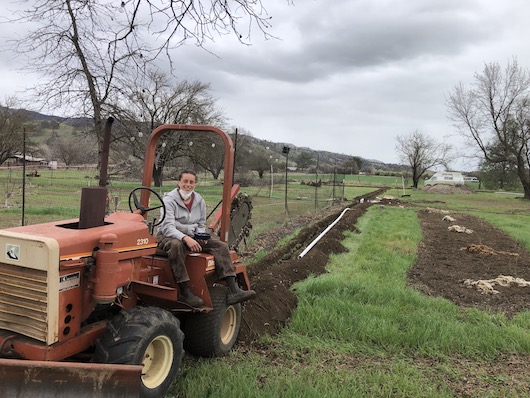
It’s that time of year again! The almond trees are blooming, transformed from bare branches into beautiful, puffy white and pink clouds.
In other years, on the last Sunday in February our farm and our neighbors in the Capay Valley host the Capay Valley Almond Festival, started in 1915 to celebrate the almond harvest and later moved to the spring to celebrate the blooming trees. The Almond Festival was cancelled for 2021. But the almond bloom is still worth celebrating. It’s the start of the process that leads to our almonds and the almond butter that so many of you know and love.
This year, in addition to celebrating the flowers, let’s also celebrate the bees! Each almond that you eat is the result of a bee pollinating an almond flower. In addition to the trees covered in blossoms, orchards are also dotted with bee hives, brought in to ensure that as many almond blossoms as possible get pollinated. Growers generally put two hives of honey bees per acre of trees. In Yolo County, the most recent numbers from 2019 show that we had 34,900 acres of almonds. That’s a LOT of bees. It’s a stark difference from just ten years ago when Yolo County had just 12,828 acres of almonds. In those ten years, a number of factors have resulted in a huge increase in almond planting in Yolo County and across the state and almonds have risen from the #7 most valuable crop in our county to #1 (in California as a whole, almonds are the second most valuable agricultural commodity). We don’t have enough bees in the state to get the job done, so bees are brought in from all over the country. It’s a huge industry that results in up to 75% of all the honey bees in the United States ending up in California each spring. For those who’re interested, the NPR Planet Money podcast did a great job explaining how hives make their way here. After the almond crop, some of these bees are used to pollinate other crops in California, others move to other crops in other states, and still others are given a period to rest.

What do we do at Full Belly? We have 43 acres of almonds, split between two different pieces of land. We don’t bring in bees to pollinate our trees. Why not? One 30-acre orchard is a later-blooming variety and the timing (and location) works out such that hives are brought up to a neighboring property to rest after finishing pollinating others’ orchards. This orchard is fairly old, with a lower yield. Many people would choose to pull it out. Four years ago we planted 13 acres of almonds. They haven’t reached full production yet but we likely will need to bring in some bees in future.
A big focus for us is the health of native bee populations. Native bees make great pollinators. There’s a growing body of research that is assessing the role that they play in pollination. It turns out that they make better pollinators than honey bees and make the non-native honey bees more efficient pollinators! Bees are often brought in to pollinate crops like melons, but studies of our farm have shown high yields of these crops without bringing in honey bees and impressive numbers of native bees in our fields. Native bees require a food source year-round to keep them healthy. In addition to the diversity of crops and flowers we grow, we also plant and maintain hedgerows and cover crops in our orchards. Some growers aren’t willing to make that investment but we think it’s important to take care of wild bee populations and are concerned about the impact of all of the honey bees brought in to pollinate the almonds. These outsider bees are more aggressive and can outcompete the local and native bees for food. They can carry diseases (you may have heard of colony collapse disorder) and can raid the hives of local bees. This is what’s happened when we’ve tried raising our own colonies of honey bees. All of this isn’t meant to villainize the California almond industry, but between water shortages and institutional investing in almonds, this seems like a good moment to address some of the problems in the industry. The Almond Board is doing research to improve the sustainability of almond harvesting, looking at things like reducing air pollution from dust during harvest and bee and native pollinator health. Imagine the kind of impact it could have if they set aside two percent of their money towards planting hedgerows, cover crops, and pollinator strips to feed pollinator species!
Bees (native and not) and other pollinators deserve a lot of thanks. Without them, our food system would look dramatically different. In recent years, bees have started to be treated as just another input to add to the system. They’ve had a tough few years, from dealing with colony collapse disorder to the impacts of recent fires. In addition to caring for the plants and the soil, their health is a priority for us too. We make design and management choices to support their health and well-being. So this year when you see a tree in bloom (particularly an almond tree) remember to thank the bees!
Elaine Swiedler
CSA Program Manager

This is what superstar Jan, the Full Belly Harvest Manager does on her weekends at our neighbor’s place!
